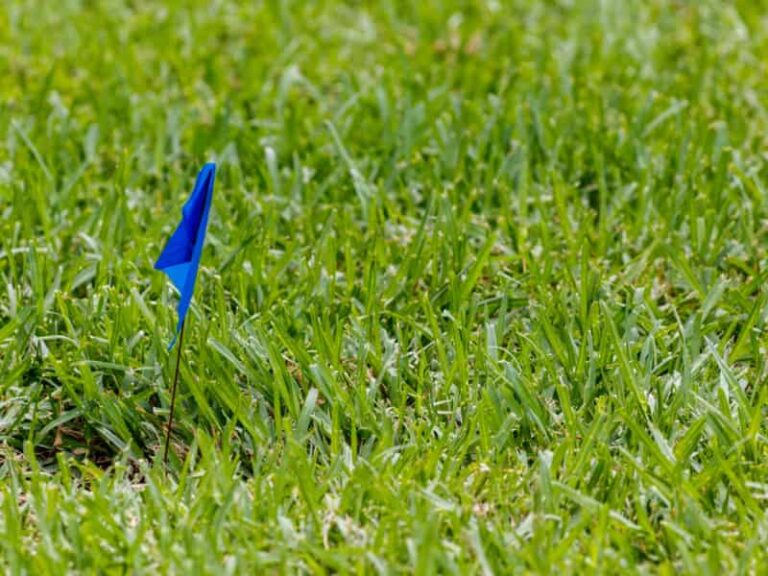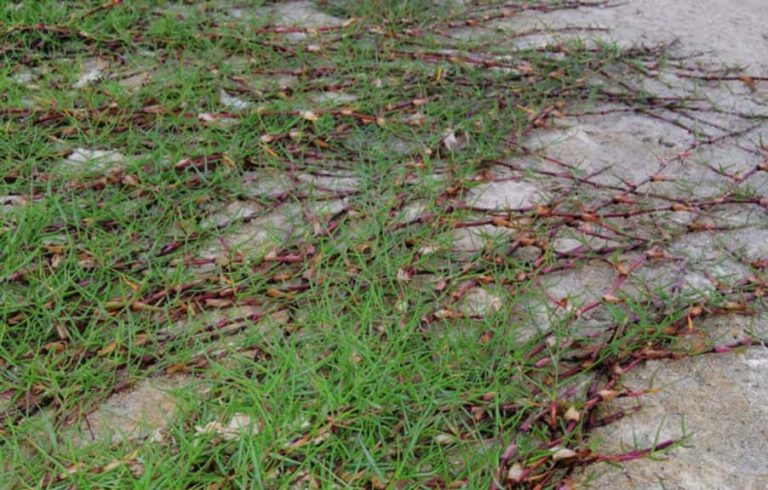Bermudagrass – Identification, Care, Planting, Cost & More
Bermudagrass (Cynodon dactylon) is a warm-season grass originating from tropical Africa but widely spread in most tropical and subtropical regions around the world. It is a highly adaptable and tolerant species, which is why it is easily found in open fields, grasslands, lawns, and waste places.
Homeowners and landscapers love Bermuda grass for its ability to withstand heavy use and tolerate a wide range of conditions, including heat, drought, and salt. In this article, I’ll extensively discuss how to establish, care for, and maintain a Bermudagrass lawn.
Table of Contents
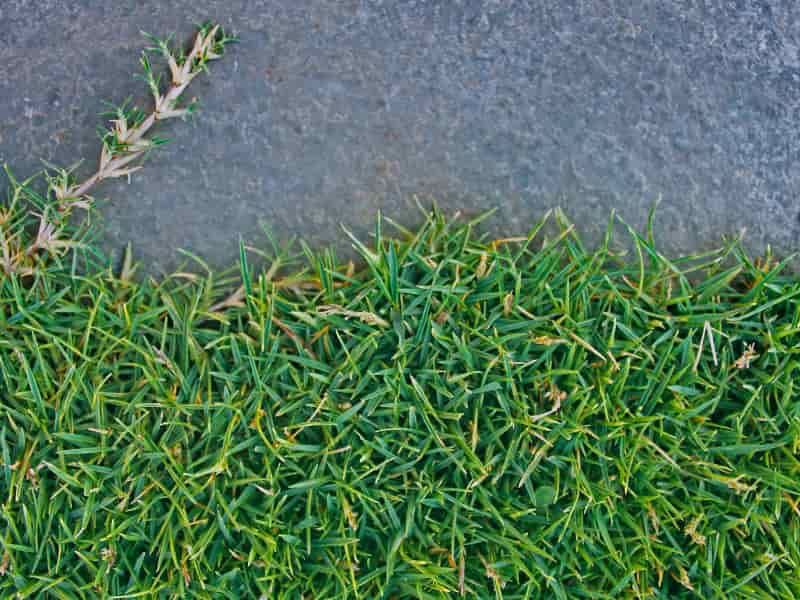
What is bermudagrass?
Bermudagrass is a warm-season, perennial grass that spreads via stolons and rhizomes to form a turf of fine leaves. The grass has a dense growth pattern with fine to medium-textured leaves and a deep green color.
Here is its taxonomical classification:[1]
- Division: Magnoliophyta
- Class: Liliopsida
- Sub-class: Commelinidae
- Order: Cyperales
- Family: Poaceae Barnhart
- Genus: Cynodon Rich.
- Species: Cynodon dactylon
A University of California paper by Larry W. Mitich on the history and taxonomy of Bermudagrass indicates that the grass was first introduced into the United States (Savannah, Georgia) around 1751 after which it spread rapidly to other parts of the country.
How to Identify Bermuda Grass (with pictures)
Common bermudagrass spreads low on the ground featuring light to dark-green, fine-textured leaves. The leaves are pointed and can be distinguished from other grasses by the small white hairs emerging at the base near the stem.
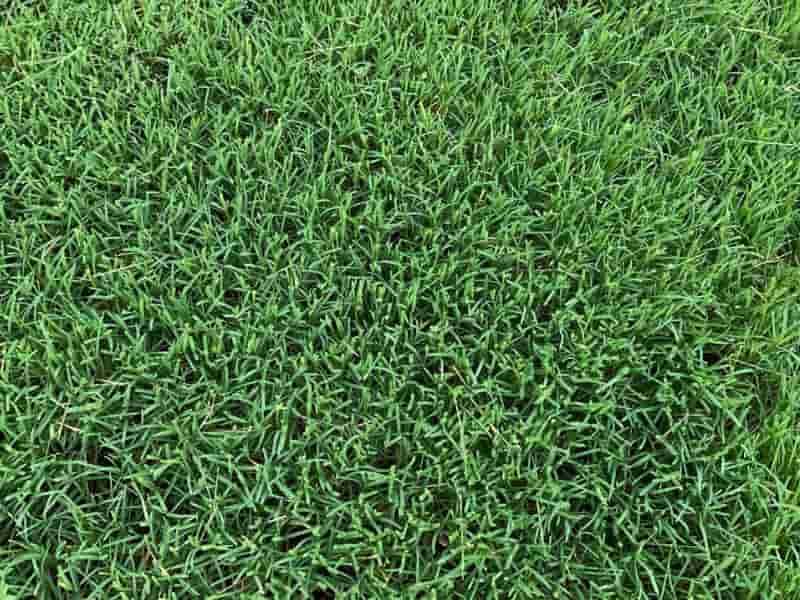
Although Bermudagrass can easily resemble large crabgrass, dallisgrass, and goosegrass to most laymen, a close examination of the leaves, stems, flowers, and roots can help identify the grass.
Leaves
Bermudagrass has soft, sharp-pointed leaf blades with rough edges that are sparsely hairy. Tufts of hair occur on the margins in the collar region. The leaves have rolled vernation, lack auricles, and have a hairy ligule.

Bermudagrass leaves are blue-green in color and grow between 2-7 inches long and 2-5mm wide.
Stems
Bermuda leaf sheaths are distinctly loose, flattened-round, with hairs occurring near the collar only. These hairs are usually 1-3mm long. The sheath margin is open.

Flowers
The Bermuda flower is an inflorescence of 3-7 spikes from a single point of origin. Each of the spikes is flat and 1-3 inches long. The spikes have double rows of spikelets that produce lance-shaped seeds which are 1.5mm long.
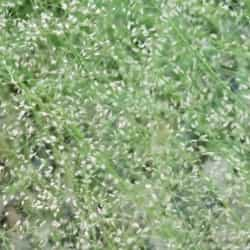
Roots
Bermudagrass has both stolons and rhizomes on the same plant. The rhizomes are scaly, while the stolons are smooth, flat, bent, and root at the nodes.
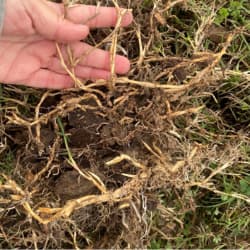
Profile table
| Bermuda Grass Characteristic | Description |
| Scientific name | Cynodon dactylon |
| Common name | Bermuda grass |
| Family | Poaceae |
| Origin | Southeast Africa |
| Habitat | Warm-season grass that thrives in full sun and well-drained soil |
| Growth habit | Rhizomatous and stoloniferous |
| Leaf blade | Fine, smooth, and green |
| Flower | Small, white flowers that appear in the summer |
| Pros | Drought-tolerant, heat-tolerant, durable, low-maintenance, high-quality forage |
| Cons | Water deeply and infrequently, mow regularly, fertilize according to the manufacturer’s directions, and control weeds |
| Uses | Lawn grass, golf courses, sports fields, pastures, hay, sod, groundcover, erosion control, xeriscaping |
| Care | Water deeply and infrequently, mow regularly, fertilize according to the manufacturer’s directions, control weeds |
How to Establish Bermudagrass Lawn
Bermudagrass is a highly tolerant, fast-growing grass, making it desirable for warm-season lawns, sports grounds, and even as a pasture grass for livestock. It can fill in bare spots and quickly develop into a thick lawn.
Most of the bermudagrass varieties used for turf are hybrids of two different Cynodon species: C. transvaalensis and C. dactylon. The lawn can be established from sod, seed, or plugs/sprigs.
Let’s look at each of these methods of propagating a bermudagrass.
Sod
Sodding is the quickest but costliest way to establish a Bermuda turf. You’ll have an instant lawn once you prepare the soil and lay down the sod pieces. If you plan to install sod on a hot day, moisten the soil with water to cool it down.
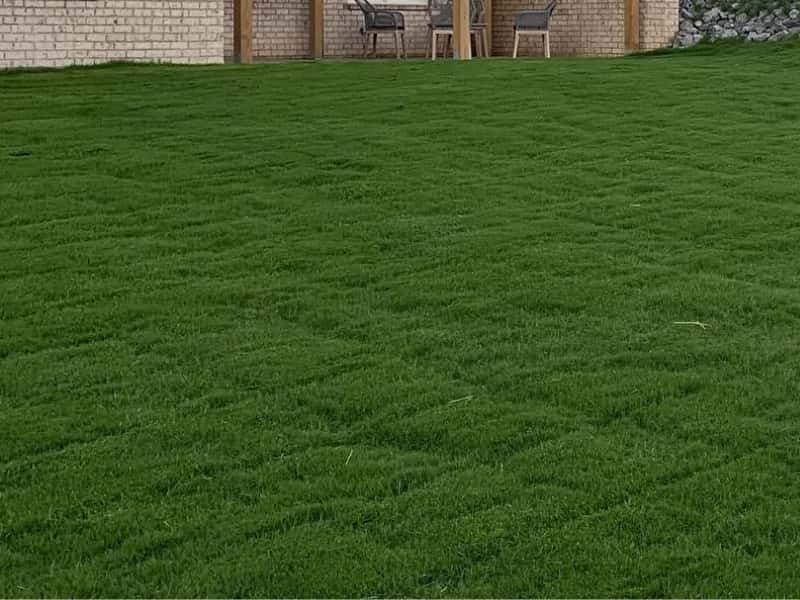
Also, you should install sod within 36 hours of purchase and delivery since it’s perishable. To properly install the sod pieces, use a masonry trowel to cut them to size, force them tight, and level small depressions.
Lay the pieces on either side of a straight line and ensure they’re staggered, as you would with flooring planks or bricks.
After laying down the sod rolls, water the lawn frequently for quick establishment of roots in the soil.
Seed
Seed propagation requires thorough preparation of the soil on site. Fixing nutrient deficiencies and drainage problems and adjusting the soil pH to 5.8-6.5 are important steps that will ensure proper seed germination and plant development.
We recommend killing both broadleaf and grassy weeds before planting grass seeds to prevent competition for sunlight, water, and nutrients.

Bermudagrass can produce 95% cover within 6 weeks of planting if the soil is well-tilled and there are no weeds to compete with the grass.
Spread Bermudagrass seed on the tilled lawn at a rate of 1.5-3 pounds per 1000 square feet. Then, drag a rake across the soil surface to incorporate the seeds into the top ⅛ inch of the soil.
Bermuda seeds take 3 to 7 days to germinate under optimal conditions and up to 21 days under Non-ideal conditions.
Spread 1-3 pounds of grass seed per 1,000 sq. ft if you’re establishing a new lawn and ½ to 1 pound per 1,000 sq. ft. if overseeding an existing lawn. Bermuda lawns can be established from seeds in about 5 to 6 weeks if all conditions are favorable.
Note: Bermuda was grown only from sod or sprigs, although it is currently available in seed form.
Plugs and sprigs
You can also propagate Bermudagrass vegetatively using plugs or sprigs. Fit the plugs into pre-cut holes and tamp them into place. The holes should be 6-12 inches apart.
Meanwhile, broadcast Bermuda grass sprigs at a rate of 7-10 bushels per 1000 square feet. Press the sprigs into shallow rows on 6-12 inch centers and cover them with soil.
It is recommended to plant bermudagrass plugs and sprigs when the soil temperature is approximately 65°F and above to prevent frost damage. As a rule of thumb, avoid planting 3 months before the first expected frost.
Tip: Bermuda grass is best established after proper soil preparation in areas with full sun and well-drained soils. Shade and less than 70% full sun will often thin out your Bermuda grass, causing a thin and sparse lawn. You can read more on Bermudagrass shade tolerance here.
Care and Maintenance
The fundamental cultural practices for maintaining Bermudagrass properly include mowing, watering, and fertilizing. Additional care and maintenance activities like aeration, dethatching, and weed control also help to keep Bermuda turfs healthy.
Soil type and pH
Bermudagrass thrives in various soil types, from heavy clay soil to sandy soil, provided the soil has nutrients. It’s also tolerant to alkaline, acidic, and saline soil conditions.
However, for a well-developed turf, I recommend providing optimal soil conditions as follows:
- Slightly acidic (a pH from about 6.5 to 7).
- Loamy soil
- Well draining.
- Organic matter
Bermudagrass struggles in poor drainage conditions, so it is best to avoid waterlogged conditions during irrigation, especially if your lawn has heavy clay or compacted soil.
You can fix soil compaction by core-aerating and topdressing with sand to allow for better drainage.
If the soil pH is below 6.5, add limestone to raise it to between 6.5-7.0, which is the optimal pH range for Bermuda grass.
Water requirements
Bermudagrass is a drought-tolerant turfgrass. It can survive in arid climates but still requires irrigation to survive in places with annual rainfall below 20 inches per year.
Drought tolerance, in this case, refers to its ability to go semi-dormant in dry conditions and recover when watered again. Aesthetically, Bermudagrass doesn’t produce desirable turf in very dry conditions.
Bermudagrass requires 1 to 1¼ inches of water weekly depending on factors such as stage of growth, type of soil, prevailing temperature, light intensity, wind, and humidity. The rule of thumb is to water deeply but less frequently to encourage roots to grow deep, making your lawn more drought-tolerant.
Base your irrigation schedule according to the soil type and the depth of the root zone. For instance, if planted in fast-draining sandy soil, the grass will need frequent irrigation compared to that growing in clay soil that holds water longer.
Bermuda roots can grow as deep as six feet, in which case deep and infrequent watering is recommended for a drought-tolerant turf.
Pro tip: Avoid watering at night as this can promote the growth of mold and mildew in your lawn. Instead, water in the morning to give the water time to soak into the soil before the sun comes up and evaporates it.
Sunlight and shade tolerance
Bermudagrass requires full sunlight for proper growth and development. If the grass is planted in a shaded area, it will struggle to spread and fill in. The optimal growth of the rhizomes, stolons, and leaves requires high light intensity.
Bermudagrass develops narrow, elongated leaves, thin erect sheaths, and weak rhizomes when continually exposed to low light intensities of less than 60% full sunlight.
To establish a thick bermudagrass lawn, prune or cut down tall trees around the yard to allow sunlight to reach the grass. Also, avoid establishing a lawn where buildings block sunlight for most of the day.
Here’s a detailed article on Bermudagrass shade tolerance.
Fertilizer
Bermudagrass requires high amounts of fertilizer to maintain its thick density and deep blue-green color.
The amount of fertilizer required and the frequency of application depends on the desired appearance, the soil type, the length of the growing season, the type of Bermudagrass, and the purpose of the turf.
For high-quality turf where the lawn is mowed frequently, apply 1-1.5 pounds of nitrogen fertilizer per 1000 square feet per month during the growing season.
However, where we do not need to push the turf to grow fast, we usually apply 0.5 pounds per 1000 sq. ft. per month. This is enough to maintain a high-quality Bermuda golf course due to its light usage.
The soil type largely influences the when and frequency of fertilizing Bermudagrass. For instance, sandy soil has a low nitrogen retention rate. Here, you’ll need frequent but light fertilizer applications.
Mowing
Mowing can make the difference between a thin and a filled-in bermudagrass lawn. The recommended mowing height is 1 inch if you want dense, wear-hardy turf. You can mow slightly lower than one inch for golf and sports turfs.
Mowing Bermudagrass above 1 inch produces a stemmy turf with poor wear-hardiness. Such a weak turf scalps easily.
However, mowing hither (typically at 2 inches high) means less frequent maintenance in terms of mowing, weeding, and watering costs.
To maintain great turf color and density, avoid removing more than 40% (one-third) of the leaf tissue when mowing. Remember, cutting a big chunk of the blades shocks the grass, resulting in stemmy growth.
Ideally, you should mow your Bermudagrass lawn at 5-7 day intervals if the mowing height is 1 inch. For the smoothest cut, use a reel mower and ensure the blades are sharpened. We recommend using a reel with 7 blades.
Remember to get rid of clippings to help prevent and control fungal disease in your lawn.
Mowing Tip: To build a multi-use lawn, allow the grass to grow to maturity first, which can take up to two seasons before mowing heavily. Remember that the lawn is still young and tender in the first year. For pasture purposes, allow Bermuda to grow for about 8 -10 weeks old before grazing.
Aeration
If the ground has a soil compaction problem, it will hinder the growth of your bermudagrass since it prevents air from reaching the root system. The right solution for compaction is core aeration.
A core aerator punches small holes into the soil and removes small plugs or “cores” of soil from the lawn, creating holes in the ground. These holes allow air, water, and nutrients to penetrate deeper into the soil, reaching the grass roots more effectively.
Improved aeration promotes healthier root growth, reduces soil compaction, and enhances water infiltration. As a result, the lawn becomes more resilient, lush, and vibrant.
Dethatching
Bermudagrass readily forms thatch, which is beneficial but can also be detrimental when it accumulates. Excessive thatch hinders proper soil water, nutrients, and pesticide penetration while harboring pests and diseases. Thus, dethatching is necessary to keep a Bermuda lawn healthy.
Dethatching a bermudagrass lawn should be done when the thatch layer is more than 0.5 inches thick. The best time to dethatch your Bermuda lawn is when the grass is actively growing.
The power tools typically used for thatch control are core aerators and power rakes. You can rent the equipment or contract a professional service.
A core aerator pulls 2-3 inch deep cores out of the soil, with the resultant plugs benefitting the soil. On the other hand, a power rake is more invasive and produces debris but gets the job done nonetheless.
Overseeding
Bermudagrass usually goes dormant in the winter. At this point, it is easy to think the grass is brown and dead.
To improve its appearance, we always recommend overseeding with cool-season turfgrass to maintain the lawn’s appearance during the cold season.
Cool-season grass varieties include:
- Annual ryegrass
- Perennial ryegrass
- Creeping bentgrass
When overseeding, apply ryegrass seed at a rate of 12-15 pounds per 1000 square feet. To help the Bermudagrass return the following spring and eliminate the ryegrass, lightly verticut the lawn and cut back on watering.
Note you can also reseed one Bermuda grass variety with a different Bermuda variety at about ½ to 1 pound per 1000 sq. ft.
Weed control
Bermuda grass has decent weed resistance but will struggle with weeds if the turf is thin. Common weeds your turf may struggle with include dandelion and chickweed.
- The best time of the year to control these weeds is in the fall when they’re still young.
- We use a selective herbicide so that you only kill the weeds and not your desirable turfgrass.
- Applying herbicides in the spring isn’t recommended, as most weeds already have taken root.
Moreover, winter weeds like chickweed die back during the summer; therefore, targeting them with herbicides in the spring is wasteful.
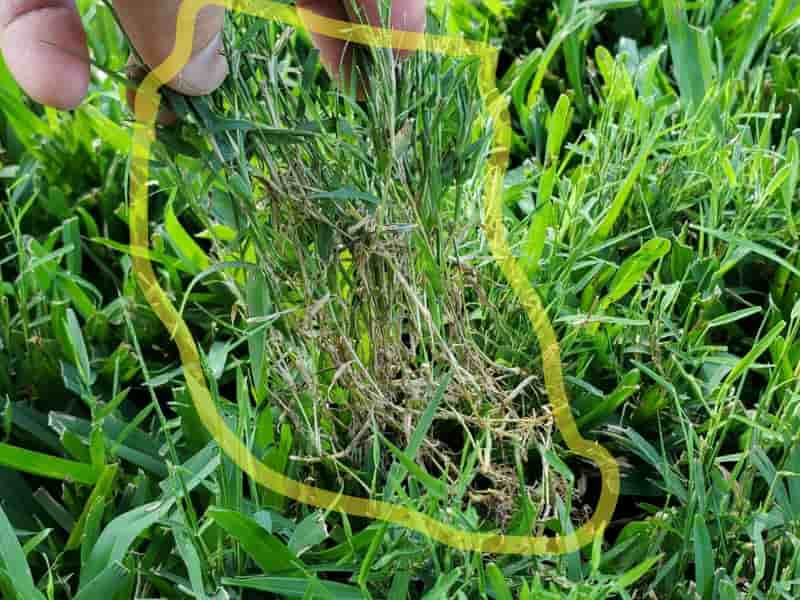
Still, you can apply pre-emergence herbicides in the spring to kill grassy weeds like crabgrass. Our go-to crabgrass killer is Tenacity Turf Herbicide, which is reliable and acts as a pre- and post-emergent herbicide.
If you notice undesired turfgrasses or broadleaf weeds growing on a certain part of your lawn, you can spot-treat the infested area using a non-selective herbicide. Spot treatment ensures you avoid killing the Bermudagrass as well.
Varieties
There are several Bermudagrass cultivars, but not all are commercially available for turf establishment.
Readily available cultivars are common Bermudagrass, improved common Bermudagrass, or hybrid Bermudagrass. These are sold as sod or seed.
- Common Bermudagrass: is the traditional Bermudagrass cultivar with distinctively wider grass blades that are light-green in color and have a lower shoot density. Common Bermudagrass is considered less desirable than improved and hybrid Bermuda cultivars.
- Improved common Bermudagrass: These cultivars boast a darker shade of green and are generally denser than common Bermudagrass. While improved common Bermudagrass has better aesthetic characteristics, it has low cold tolerance for the first year after establishment. Example varieties include Yukon, Sahara, LaPaloma, Riviera, and Princess 77.
- Hybrid Bermudagrass: These cultivars are produced by crossbreeding two Bermudagrass species and have the most desirable appearance and disease-resistance characteristics. They can only be propagated vegetatively, as they produce sterile seeds. Example varieties include Tiflawn, Tifway, TifGrand, TifSport, and GN-1.
Learn more about the different varieties of bermudagrass here.
Pests
Common Bermudagrass pests are armyworms, fire ants, and grubs. Use insecticide sprays and insecticide-based baits to control these insects.
Always follow the manufacturer’s safety instructions when using pesticides on Bermudagrass.
Diseases
Bermudagrass has low disease potential compared to similar turf grasses. However, it’s vulnerable to spring dead spots, a fungal disease that causes round patches of dead grass. The patches are usually 6-12 inches in diameter.
The best way to prevent spring dead spots is by growing a resistant cultivar, such as cold-tolerant varieties.
To control the fungal disease, use a fungicide. Meanwhile, to prevent other Bermudagrass diseases like dollar spot and large patch (brown patch), adopt the correct watering, fertilizing, and mowing practices.
Other Problems with Bermuda Grass
Additional problems that you may notice on a Bermudagrass lawn include:
- The turf turns yellow due to iron or nitrogen deficiency.
- The grass blades turn brown and crispy due to extended periods of drought.
- Bare spots and thinning of the grass due to shade/insufficient sunlight.
- Leaf blade streaking and yellowing due to fertilizer burn.
Bermuda Grass Growth Stages
The growth stages can be divided into soil/yard preparation, germination, seedlings, establishment, and maturity.
Here are 6 stages involved in establishing a lush Bermuda grass lawn namely:
Germination Stage
Preparing the soil for planting forms the basic part of the lawn establishment. It involves:
- Testing and amending soil to achieve an optimum pH.
- Removing weeds and any other debris that may hinder seeds from germinating.
- Raking the soil to level, smoothen, and loosen the soil.
- Watering the area deeply to create a moist medium.
- Sowing the seed in the spring or fall when the weather is mild (Broadcast at a rate of 1-2 pounds per 1,000 square feet).
Tip: Ensure the area receives full sun (spring or fall) with well-drained soil with a pH between 6.0–7.0. The seeds will take up to a week to germinate under optimal conditions, during which you should water well to keep the soil moist.
Root development is crucial and dependent on seed quality and soil conditions (moisture level and temperature).
At this stage, the roots develop and determine how fast the grass will grow since they determine the access to water and nutrients.
Seedling Stage
Germination has occurred, and roots are well established at this stage. However, the roots are still weak and prone to drought. If it’s an already established lawn, ensure the soil is well-drained and thatch-free.
Planting the Bermuda seedlings in spring when soil temperatures are warm (60°F or above) and moist is best.
Grass seedlings grow slowly in their first year of establishment, so ensure you irrigate well since drought can cause serious injury to young plants.
Once the seedlings are established, they develop rhizomatous roots that help them spread rapidly by stolons and rhizomes into surrounding areas to fill the lawn. These root fragments sprout new shoots at nodes/joints every few inches along their length, making the grass dense.
Branching Stage
At this stage, the rhizomes start to grow above ground to form new shoots, known as “rhizome branching,” which will become the Bermuda grass stolons.

Once this happens, they form fresh green buds on top of each rhizome, called “tillers,” which slowly grow into new leaves.
Flowering Stage
The inflorescence emerges once the new leaves form (stems, stalks, bracts, and flowers). Majorly the small white flowers emerge in spring when triggered by light and warmth.
Although flowering is part and parcel of the Bermuda grass life cycle, it tends to show that the grass might be under some type of stress.
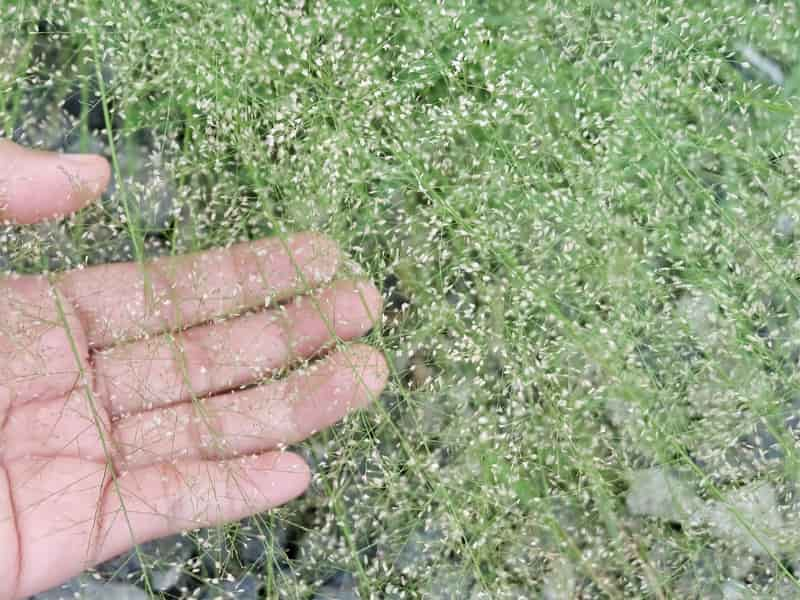
Tip: Bermuda grass tends to flower under stress like diseases, insect infestation, inadequate nutrients, compaction, and underwatering. You should consider dethatching, aerating, fertilizing, and watering deeply and infrequently.
Mowing frequently while collecting seed heads is recommended, as the species can be invasive.
Dormancy Stage
Once the temperature hits 95°F to 100°F, the Bermuda grass will go dormant and stop growing. Rhizomes and stems die back in summer and later regrow in spring.
The rhizomes remain underground until the weather becomes favourable again to regrow.
Tip: Water the grass well during the growing season to prevent stunting in the summer.
Establishment Stage
At this stage, the lawn is well-established and lush if well-cared for. Deep watering once per week and other care and maintenance practices will help Bermuda grass establish well.
| Stage | Timeframe | Cost | Activities |
| Preparation | 1-2 day | $20-50 per 1,000 square feet | Cost of the seed, fertilizer, and labour. |
| Seeding | 1 day | $0.25-0.50 per square foot | Cost of the seed, fertilizer, and labor. |
| Germination | 5-7 days | >$10 per 1,000 square feet | Cost of watering the lawn. |
| Establishment | 30-60 days | $10-20 per month | Cost of watering, mowing, and fertilizing the lawn. |
| Maturity | 60+ days | $5-10 per month | Cost of watering, mowing, and fertilizing the lawn. |
Note: The actual time taken can vary depending on soil conditions, climatic factors, and establishment method, as discussed above.
Bermudagrass Lawn Care Schedule/ calender
Here is a summary table and comprehensive report on the recommended care and maintenance schedule for Bermudagrass
| Timeframe | Care & Maintenance Tips |
|---|---|
| Spring (Mar-May) | Mow when the grass turns green; set the mower low without scalping. Mow before the grass gets over 2.5 inches tall. Fertilize with 0.5-1 lb nitrogen/1,000 sq ft after green up. Apply pre and post-emergent herbicides. Water 1 inch per week |
| Summer (Jun-Aug) | Mow to a height of 0.6-2.5 inches. Fertilize with 1-1.5 lbs nitrogen/1,000 sq ft every 4-6 weeks. Monitor for pests like white grubs |
| Fall (Sep-Nov) | Gradually reduce mowing frequency and height. Apply max 0.5 lbs nitrogen/1,000 sq ft in early fall. Control broadleaf weeds before dormancy. Aerate compacted areas |
| Winter (Dec-Feb) | Remove leaves/debris to allow faster spring green-up. Control winter annual weeds. Do not fertilize dormant grass. |
Uses of Bermuda Grass
Bermuda grass is versatile grass with many uses commonly used for:
- Golf courses and sports fields: It’s a common choice for golf courses because it is durable and can withstand heavy foot traffic.
- Pastures and hay: It is a good forage grass for livestock due to its high protein content.
- Home lawn establishment as it grows fast, and its sod can be installed quickly.
- Great ground cover since it is low-maintenance grass, which can withstand foot traffic and drought. It can also be used for erosion control in areas prone to landslides or flooding to stabilize and compact soil.
- Xeriscaping– a good choice for xeriscaping since it’s drought-tolerant and can handle areas with limited water availability.
FAQs
Should I cover Bermuda seeds after planting?
Yes, lightly cover your seeds with 1/8 to 1/4 inch of soil to allow sunlight for good seed germination.
Where should I establish Bermuda grass lawns?
It’s best to establish Bermuda grass in warm areas that receive full sun (Ideally for USDA Zones 7 through 10) in southern regions of the U.S. However, some bermudagrass varieties can survive in the transitional zone too. Bermuda grass remains green all year but goes dormant when temperatures drop to 60°F and below.
Can I overseed Bermuda with Zoysia?
We don’t recommend overseeding Bermuda with Zoysia, as both are warm-season grasses that go dormant in the winter. Instead, overseed Bermuda with a cool-season variety like ryegrass or bluegrass.
Is Bermuda grass good for a lawn?
Yes, Bermuda grass forms the best turf lawns in well-drained soils, grows fast, and can fill bare spots quickly. As a warm-season grass, it can tolerate heat, pests, drought, and high foot traffic with minimal maintenance practices like watering, mowing, and fertilization. You can establish Bermuda in clay soil, but it does not do well in cold weather.
What are the cons of Bermuda grass?
Bermuda is a highly invasive grass that can take over from other turf grass. It’s intolerant to cold and is affected by shade from bushes and trees. It’s also susceptible to weeds and pest invasions like crabgrass, chinch bugs, and mites. If your area is prone to cold winters or has a lot of shade, Bermuda grass may not be the best choice for your lawn.
Where does Bermuda grass grow best?
Bermuda is a warm-season grass that grows best in regions with mild winters and hot – humid summers (USDA zones 7a – 10b). Mostly used turfgrass in the southeastern United States, from North Carolina to Florida and west to Texas golf courses and sports fields such as baseball and football. It’s also established in coastal regions since it’s salt tolerant and desert areas, although it requires more frequent irrigation than in other regions. Bermuda grass best suits regions with sandy loam soils, mild winters, and hot and humid summers.
Reference
D. W. Cudney, Botany/Plant Sciences emeritus, UC Riverside; C. L. Elmore, Veg Crops/Weed Science emeritus, UC Davis, C. E. Bell, UC Cooperative Extension, San Diego Co. University of California Statewide IPM Program: Bermudagrass.
Larry W. Mitich, University of California, Agriculture and Natural Resources: History and Taxonomy of Bermuda grass,
David M. Kopec, Extension Turfgrass Specialist, University of Arizona Cooperative Extension: History and facts of Bermuda grass.

